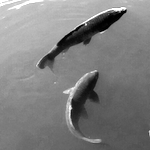The hydrodynamics of coordinated swimming in fish and other aquatic animals have been the focus of extensive research over the past five decades. Collective movement in fish serve various purposes, such as enhancing foraging efficiency, providing protection against predators, and reducing energy expenditure during swimming. Fish schools display diverse arrangements, and multiple mechanisms have been proposed to explain the hydrodynamic advantages of schooling. In this study, we employ direct numerical simulations to demonstrate that a carangiform fish, can significantly enhance its swimming performance by positioning itself in the wake-induced flow of a leading fish, thereby augmenting the leading-edge vortex (LEV) on its own fin.
Our simulations reveal potential improvements of up to 12% in both the thrust and efficiency of the trailing fish through this mechanism. To analyze the underlying mechanisms, we apply the force partitioning method, a robust data-driven approach that segregates the pressure forces acting on the fish into distinct components based on their mechanics. The analysis uncovers the dominance of the LEV on the fin in thrust production for these swimmers. Consequently, enhancing the LEV represents an effective and reliable means of harnessing hydrodynamic interactions between fish in a school. To explore the robustness of this phenomenon further, we investigate increasingly larger schools of fish.
Moreover, the data obtained from these high-fidelity simulations are utilized to parameterize a novel agent-based model of schooling fish of fish schools comprising O(100) individuals. We then also explore the implications of vision and lateral line sensing in the formation of fish schools.

 PDF version
PDF version
